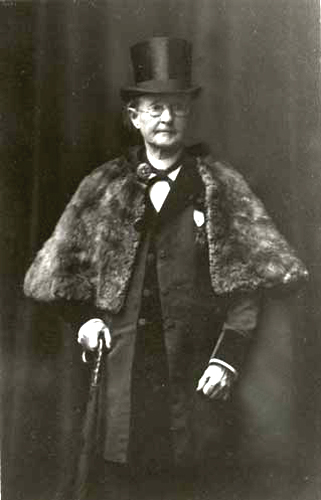

Queer Places:
State University of New York, 750 E Adams St, Syracuse, NY 13210, Stati Uniti
Rural Cemetery, 242 Cemetery Rd, Oswego, NY 13126, Stati Uniti
 Mary
Edwards Walker (November 26, 1832 - February 21, 1919),
commonly referred to as Dr. Mary Walker, was an American
abolitionist, prohibitionist,
prisoner of war and Civil War surgeon. She was the first
and only woman to ever receive the Medal of Honor.[1]
Mary
Edwards Walker (November 26, 1832 - February 21, 1919),
commonly referred to as Dr. Mary Walker, was an American
abolitionist, prohibitionist,
prisoner of war and Civil War surgeon. She was the first
and only woman to ever receive the Medal of Honor.[1]
Walker defied the wearing of women’s clothing in multiple ways throughout her lifetime. The most dramatic of these took place when she was hired as the first woman physician by the U.S. Army during the Civil war, and donned male attire to cross enemy lines and spy on the Confederate Army. Caught and imprisoned in Richmond, Virginia, Walker continued to refuse to wear women’s clothing and pressed on in her work for dress reform after the war. She became the first woman to receive the U.S. Medal of Honor and requested and received a post as surgeon at a women’s prison in Louisville. While Walker was married for a time and may have been heterosexual, she was also frequently accused of lesbianism and at a minimum was, according to her biographer, “female-identified” in the sense that she preferred female companionship. It is also fair to speculate that, had she lived in a later period of history, Walker may well have embraced a transgender or gender queer identity, so great was her consistency and determination in defying norms of female dress.
In 1855, Walker earned her medical degree at Syracuse Medical College in New York,[2] married and started a medical
practice. She volunteered with the Union Army at the outbreak of the
American Civil War and served as a surgeon at a temporary hospital
in Washington, DC, even though at the time women and sectarian
physicians were considered unfit for the Union Army Examining Board.[3] She was captured by Confederate forces
after crossing enemy lines to treat wounded civilians and arrested as a
spy. She was sent as a prisoner of war to Richmond, Virginia, until
released in a prisoner exchange.
After the war, she was approved
for the highest United States Armed Forces decoration for bravery,
the Medal of Honor, for her efforts during the Civil War. She is the
only woman to receive the medal and one of only eight civilians to
receive it. Her name was deleted from the Army Medal of Honor Roll in
1917 (along with over 900 others); however, it was restored in 1977. After the war, she was a writer and lecturer supporting the
women's suffrage movement
until her death in 1919.
Inspired by her parents' novel standard
of dressing for health purposes, Walker was infamous for contesting
traditional female wardrobe. In 1871, she wrote, "The greatest sorrows
from which women suffer to-day are those physical, moral, and mental
ones, that are caused by their unhygienic manner of dressing!" She strongly opposed women's long skirts with numerous
petticoats, not only for their discomfort and their inhibition to the
wearer's mobility but for their collection and spread of dust and dirt.
As a young woman, she began experimenting with various skirt-lengths and
layers, all with men's trousers underneath. By 1861, her typical
ensemble included trousers with suspenders under a knee-length dress
with a tight waist and full skirt.
While
encouraged by her family, Walker's wardrobe choices were often met with
criticism. Once, a schoolteacher, she was assaulted on her way home by a
neighboring farmer and a group of boys, who chased her and attacked her
with eggs and other missiles. Female colleagues in
medical school criticized her choices, and patients often gawked at her
and teased her. She nevertheless persisted in her mission to reform
women's dress. Her view that women's dress should "protect the person,
and allow freedom of motion and circulation, and not make the wearer a
slave to it" made her commitment to dress reform as great as her zeal
for abolitionism. She famously wrote to the women's
journal, ''The Sibyl: A Review of the Tastes, Errors, and Fashions of
Society'', about her campaign against women's fashion, amongst other
things, for its injuries to health, its expense, and its contribution to
the dissolution of marriages. Her literature
contributed to the spread of her ideas, and made her a popular figure
amongst other feminists and female physicians.
My published books: